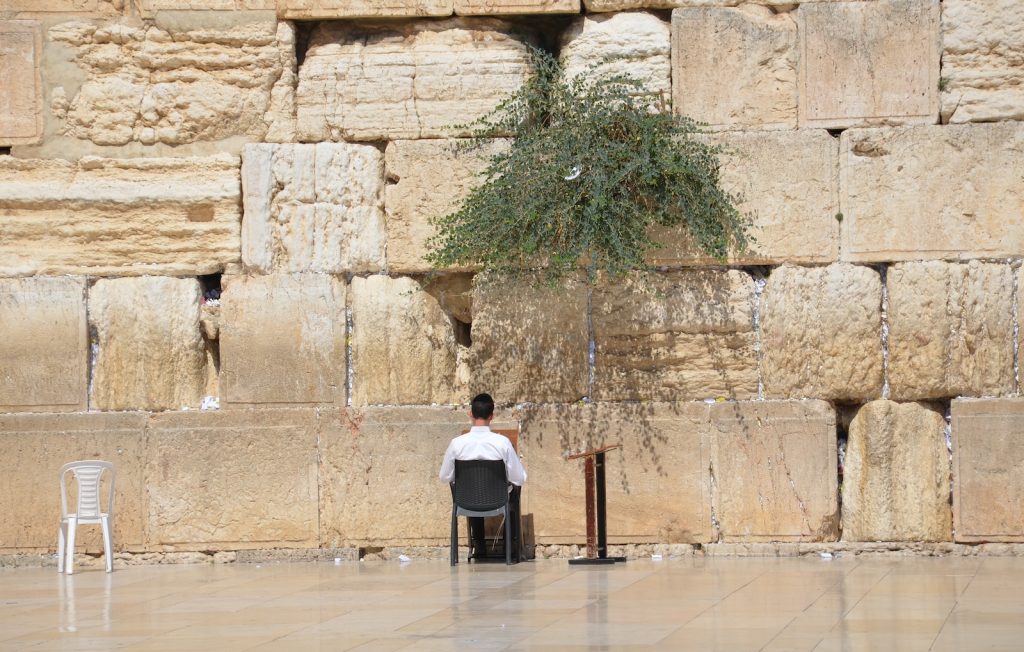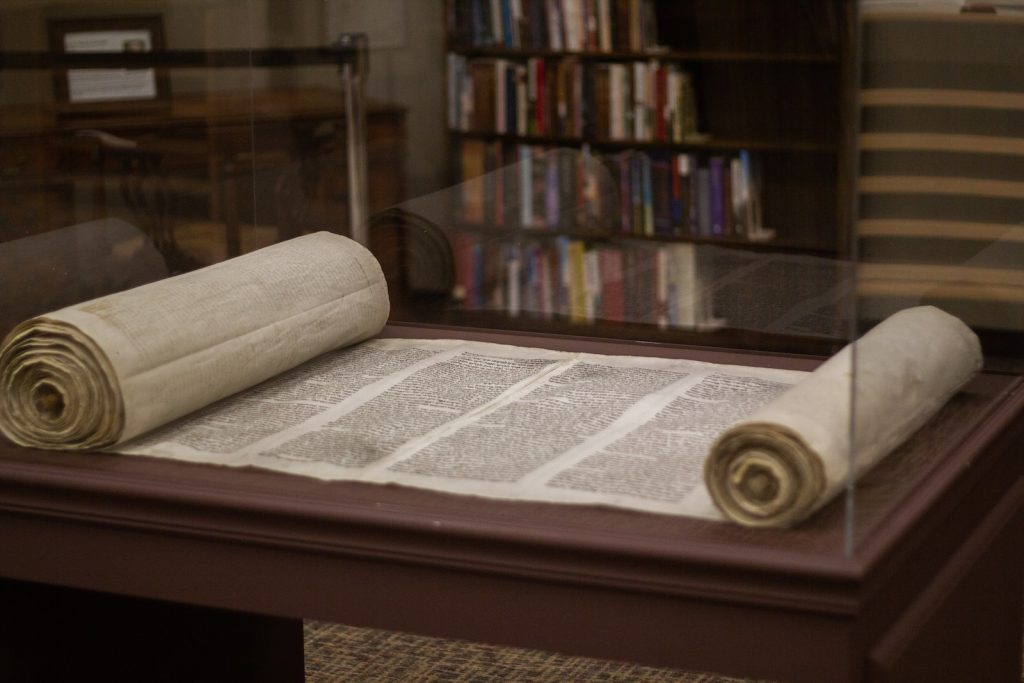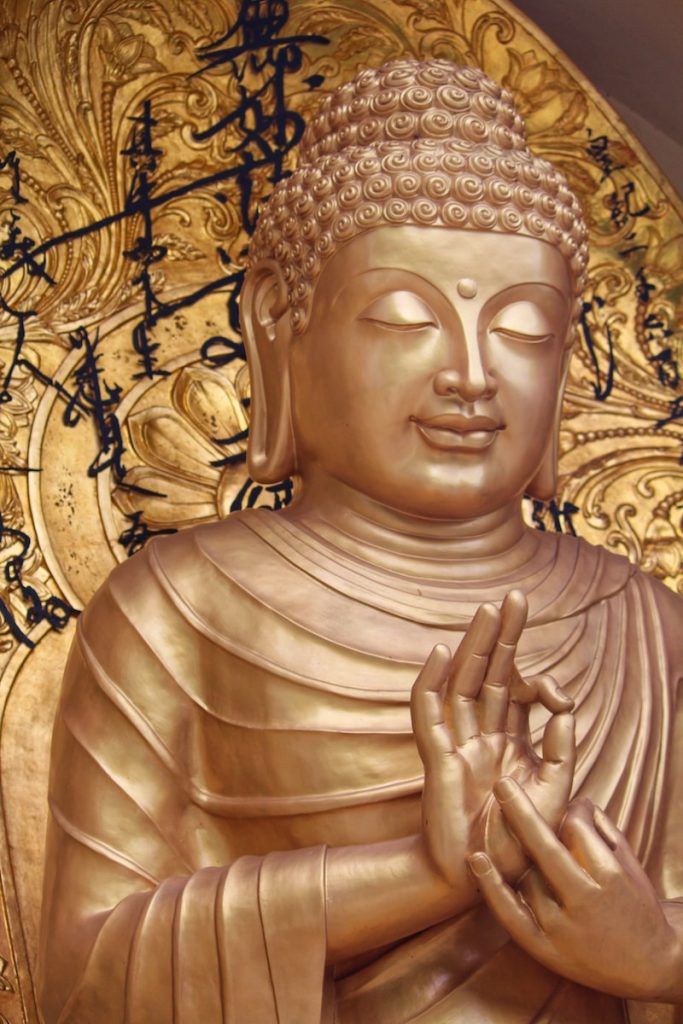The use of finger or hand movements in Jewish prayer is a practice that dates back to biblical times. These movements, also known as mudras, are used to enhance the spiritual experience of the worshipper, and to help them focus their mind on the divine. In Judaism, mudras are used during prayer, Torah reading, and the Priestly Blessing, among other religious ceremonies.

One of the most common mudras used in Jewish prayer is the hand gesture known as the Cohanim blessing, or Birkat Kohanim. This gesture involves the Cohanim, or Jewish priests, raising their hands and extending their fingers in a specific pattern while reciting a blessing over the congregation. The exact origin and meaning of this gesture is not known, but it is believed to have been used since biblical times.
Another mudra commonly used in Jewish prayer is the hand gesture known as the V-shaped hand configuration. This gesture is used during the Torah service, specifically for the line “And this is the Torah that God gave to Moses.” While the exact meaning of this gesture is unknown, it is believed to be a symbol of reverence and respect for the Torah, and a reminder of the divine origin of Jewish law.
Historical Context of Hand Gestures in Judaism

Hand gestures have been a significant part of Jewish tradition for centuries. The use of finger or hand movements has been observed in various Jewish practices, including prayer, blessings, and other religious ceremonies. The historical context of hand gestures in Judaism can be traced back to the biblical era and has evolved over time through rabbinic literature and Jewish tradition.
Biblical References to Hand Movements
The Torah contains several references to hand movements used in Jewish practices. For instance, in Exodus 17:11, Moses raised his hands to pray during the battle against the Amalekites. Similarly, in Exodus 9:29, Moses stretched out his hand to bring an end to the hailstorm that was devastating Egypt. These references indicate the use of hand movements as a form of prayer and supplication.
Talmudic Development of Hand Gestures
The Talmud is a central text in Jewish tradition that provides a detailed account of the development of hand gestures in Judaism. The Talmudic sages introduced various hand gestures for blessings and prayers, including the priestly blessing, Birchat Kohanim, which involves outstretched hands and spread fingers. The Talmud also mentions other hand gestures such as the covering of the eyes during the Shema prayer and the placement of hands on the head during the confessional prayer.
In conclusion, the use of finger or hand movements in Judaism has a rich historical context that has evolved over time through biblical references, rabbinic literature, and Jewish tradition. Hand gestures are an integral part of Jewish practices, and their significance has been passed down through generations.
Religious Significance of Hand Gestures

Hand gestures have significant religious and spiritual importance in Judaism. These gestures are used in various rituals, prayers, and blessings. The use of hand gestures is believed to have symbolic significance and is considered a way of communicating with G-d.
Symbolism in Jewish Rituals
In Jewish rituals, hand gestures are used to symbolize various concepts and ideas. For instance, the priestly blessing, which is recited by the Kohanim, involves a specific hand gesture. The Kohanim raise their hands with palms facing downward and fingers spread apart while reciting the blessing. This gesture is believed to represent the outpouring of divine blessings.
Another example of hand gestures in Jewish rituals is the Shema. During the recitation of the Shema, the worshipper covers their eyes with their right hand. This gesture is believed to represent the idea of focusing one’s thoughts and intentions on the words of the prayer.
Hand Movements in Prayer and Blessings
Hand movements are also an integral part of Jewish prayer and blessings. For instance, during the Amidah, worshippers move their bodies back and forth while reciting specific prayers. This movement is believed to represent the idea of standing before G-d and humbling oneself in His presence.
In addition, specific hand gestures are used during prayer and blessings. For example, when reciting the Priestly Blessing, the Kohanim form the shape of the Hebrew letter Shin with their hands. This gesture is believed to represent one of the names of G-d and is considered a way of invoking His divine presence.
Similarly, during the recitation of blessings, the worshipper may use specific hand gestures to emphasize the words of the blessing. For instance, when reciting the blessing over bread, the worshipper holds the bread in their left hand and covers it with their right hand while reciting the blessing.
In Kabbalah, a mystical Judaic sect, the fingers of the hands represent the Ten Sefirot, which are the ten attributes through which G-d interacts with the world. Each finger is associated with a specific sefirah and is believed to have its own unique spiritual significance.
In conclusion, hand gestures have significant religious and spiritual importance in Judaism. These gestures are used to symbolize various concepts and ideas and are considered a way of communicating with G-d. The use of hand gestures in Jewish rituals, prayers, and blessings is an integral part of Jewish tradition and is believed to enhance the worshipper’s spiritual experience.
Hand Gestures in Contemporary Jewish Practice

Hand gestures are an integral part of Jewish practice, and they are used to convey different messages, express emotions, and enhance concentration. In contemporary Jewish practice, hand gestures play a significant role in synagogue services and Torah study.
Gestures in Synagogue Services
During synagogue services, hand gestures are used to enhance the prayer experience and emphasize certain parts of the liturgy. For example, when reciting the Shema, Jews place their right hand over their eyes to block out distractions and focus on the words of the prayer. Similarly, during the Amidah, Jews stand with their feet together and their hands clasped in front of them to demonstrate their concentration and devotion.
Another notable hand gesture in synagogue services is the Kohanic Blessing, which is performed by the Kohanim (descendants of Aaron) during certain holidays. The Kohanim extend their hands and fingers in a specific formation to bless the congregation, as described in Chabad.org.
The Role of Hand Movements in Torah Study
In Torah study, hand movements are used to emphasize important points and help with concentration. For example, when reading from the Torah scroll, Jews use a yad (a pointer) to follow the text and avoid touching the sacred parchment. The yad is also used to underline important words and phrases, as described in My Jewish Learning.
Hand movements are also used during Torah study to perform mitzvot (commandments) such as shaking the lulav and etrog during the holiday of Sukkot. Jews hold the lulav and etrog in their right hand and shake them in six directions to symbolize God’s presence in all directions.
In conclusion, hand gestures play a vital role in contemporary Jewish practice, and they are used to enhance concentration, express emotions, and perform mitzvot. Whether in synagogue services or Torah study, hand movements are an essential part of the Jewish experience.
Cultural Expressions and Art

Jewish culture has a rich history of artistic expression, including the use of hand motifs in art. These symbols can have religious, cultural, and social significance.
Hand Motifs in Jewish Art
One of the most recognizable hand motifs in Jewish art is the Hamsa. The Hamsa is a hand-shaped amulet often used for protection against the evil eye. The symbol is also known as the Hand of Fatima in Islam and is used in many cultures throughout the Middle East and North Africa. The Hamsa is often decorated with the Star of David, another important symbol in Jewish culture.
The Star of David is a six-pointed star made of two overlapping triangles. The symbol is often used to represent the Jewish people and their connection to God. It is also a common motif in Jewish art, appearing on everything from jewelry to synagogue decorations.
Another hand motif in Jewish art is the fish. The fish is a symbol of fertility and abundance and is often used in Jewish art to represent the blessing of children. The fish is also a symbol of protection, as it is said to protect against the evil eye.
Cross-Cultural Symbols and Their Influence
Jewish art has been influenced by many different cultures throughout history. One example is the use of the Hand of Fatima in Jewish art. This symbol originated in Islam but has been adopted by Jewish artists as a way to protect against the evil eye.
Another example is the evil eye, a symbol of protection against negative energy. The evil eye is a common motif in Jewish art, as well as in many other cultures throughout the world.
In conclusion, hand motifs have played an important role in Jewish art and culture for centuries. These symbols have religious, cultural, and social significance and have been influenced by many different cultures throughout history.
Protective and Superstitious Aspects

Judaism has a rich history of protective and superstitious beliefs associated with finger and hand movements. These beliefs are rooted in the idea that certain movements can ward off evil and bring good fortune. Two common aspects of these beliefs are amulets and good fortune.
Amulets and the Evil Eye
Amulets are believed to protect the wearer from the evil eye, a curse believed to cause harm or bad luck. The hamsa, a hand-shaped amulet, is a popular symbol in Judaism and is believed to offer protection from the evil eye. The hamsa is often inscribed with the word “Shaddai,” which is associated with the name of God. The use of the hamsa as an amulet dates back to ancient times and is still prevalent today.
Good Fortune and Luck in Judaism
In Judaism, good fortune and luck are often associated with certain hand movements. For example, crossing fingers is not a Jewish practice, but closing prayer books, Bibles, and talmudic tracts is a common practice in synagogues and study halls. This is believed to protect the holy knowledge contained in these texts from being used for nefarious purposes by devils and demons [1].
Another example of a hand movement associated with good fortune is the use of the ben ish chai hand gesture. This gesture involves touching the thumb to the pinky and the ring finger to the middle finger, leaving the index finger extended. It is believed to bring good fortune and is often used during prayer [2].
Overall, while there are some superstitious beliefs associated with finger and hand movements in Judaism, they are not considered forbidden or witch-like. Rather, they are seen as a reflection of religious belief and tradition. King Solomon is believed to have used hand gestures in his magical practices, and this has influenced some Jewish mystical traditions [3].
[1] Source: My Jewish Learning
[2] Source: Chabad.org
[3] Source: Religions Facts
Controversies and Misunderstandings

Misconceptions About Jewish Hand Gestures
There are several misconceptions about Jewish hand gestures that have caused controversies and misunderstandings. One of the most common misconceptions is that all hand gestures used by Jews have a religious significance. While some hand gestures do have religious significance, not all of them do. Some hand gestures are simply cultural and have no religious significance.
Another misconception is that Jewish hand gestures are unique to Judaism. In reality, many of the hand gestures used by Jews are also used by other cultures and religions. For example, the gesture of raising the hands in supplication is used by many cultures and religions, not just Judaism.
There are also misunderstandings about the meanings of some Jewish hand gestures. For example, the gesture of crossing the fingers is often misunderstood as a sign of good luck or a way to ward off evil. In Jewish tradition, however, crossing the fingers is a gesture of chesed, or kindness, and is used to express a desire for mercy or compassion.
Scholars of Jewish tradition have also noted that some hand gestures have different meanings depending on the context in which they are used. For example, the gesture of raising the hands in supplication can be a sign of gevura, or strength, when used in the context of a prayer for justice.
Overall, it is important to understand that Jewish hand gestures are not always religious in nature and that their meanings can vary depending on the context in which they are used. By understanding the significance and context of these gestures, we can avoid misunderstandings and promote greater understanding between cultures and religions.
Practical Applications

Incorporating Hand Gestures in Personal Worship
The use of hand gestures in personal worship is a common practice in Judaism. During prayer, individuals may use hand gestures to enhance their connection with God and express their devotion. For example, when reciting the Amidah, worshippers may raise their hands to the heavens or cover their eyes to focus on their prayers. The use of hand gestures during prayer is believed to help individuals focus their thoughts and emotions on their spiritual connection.
The use of hand gestures is also common during the recitation of the confessional prayer. Worshippers may strike their chest with their fist or their open hand to express remorse for their sins. This practice is believed to help individuals connect with the gravity of their transgressions and express their desire for forgiveness.
Educational Use of Gestures in Teaching Judaism
Hand gestures are also used in educational settings to teach Judaism. For example, the tzitzit, a fringed garment worn by observant Jews, is often used to teach the importance of following God’s commandments. The tzitzit has four corners, each with a tassel, and is worn as a reminder of God’s commandments. When teaching about the tzitzit, educators may use hand gestures to demonstrate the placement and significance of the tassels.
In addition, the use of hand gestures is common when teaching the Ten Commandments. Educators may hold up their hands to represent the tablets on which the commandments were written, or use their fingers to count the commandments.
Conclusion
Overall, the use of hand gestures in Judaism has practical applications in personal worship and educational settings. Hand gestures are used to enhance the spiritual connection between individuals and God, as well as to teach important concepts and beliefs. While the use of hand gestures is not required in Judaism, it is a common practice that has been passed down through generations.
Dr. Harlan Kilstein is a certified yoga teacher, hypnotherapist, and a teacher of the Law of Attraction since 1975.
After an immersion in yoga and his certification by the Yoga Alliance, he began studying mudras and invented Finger Healing.




